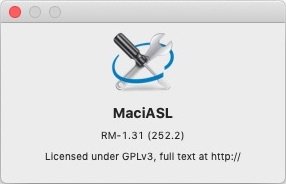-
Posts
10067 -
Joined
-
Last visited
-
Days Won
569
Content Type
Profiles
Articles, News and Tips
Forums
Everything posted by Hervé
-

E7470 : mouse lag when plugged into USB 3 port (not on USB2 port)
Hervé replied to grui's topic in The Archive
Are you sure it's a USB3.0 dongle for a mouse? What speed does it report at in SysProfiler/SysInfo->USB? -
Did you check your power management settings (Terminal command pmset -g + Energy Saver PrefPane)?
-
Well, it's been over 20mins and the CN-096JNT has not killed the laptop. That's a huge difference! However, it's not entirely kosher because, in that period of time, I experienced 2 x wireless disconnections accompanied brief and partial system freezes until the wireless reconnected automatically. During the short freeze, my external USB mouse was unresponsive but my TouchPad was still active. Will have to look in the longer term and, possibly, just remove the brcmfx-country=#a option I went with. To be continued...
-
Not much guidance needed, come on! Inject or cache AirportBrcmFixup kext and add those 2 x boot options visible in DalianSky's Clover config. That's the only things that differ, the properties injection detailed in my guide are otherwise strictly identical. I'm now testing this with my CN-096JNT model which caused issue usual overload/freeze issues when initially tested in my 7490.
-
Same thing for @muttonhead411: the sticker of your card does not match the hardware specs and the real MAC @ differs from the sticker's ! So, no, it's not a DW1820a 0VW3T3 model. This being said, it's interesting that you report that the 1028:0023 model works for you. You're using AirportBrcmFixup + boot option brcmfx-driver=1 as I had suggested a few weeks ago and I'm wondering if you could test it without AirportBrcmFixup + the associated boot options and tell us how it goes. It may well be that, for those cards that end up clogging the Hackintosh to a halt, It's actually required. I'm going to try that with the CN-096JNT model I recently acquired.
-
Battery status disappearing is very common on those older Latitude models (eg: E6x30, E6x40, E7x40). It's probably due to some missing battery DSDT patch required for Rehabman's ACPIBatteryManager kext to work properly. No idea about the patch, never looked into it.
-
You may refer to the wikidevi link provided in our wireless inventories for details of the DW1820a (not to be confused with DW1820).
-
WWAN antennas are too short for the WLAN slot in the 7490. DW1560 is a better alternative than the DW1830. NB: I purchased my DW1820a off the well-known auction site; I'll send you details of the seller by PM.
-
CPU model does not matter, except in the the case where you would try to re-use the CPU-related power management SSDT of another CPU. That would not work. Now, don't get confused. Pike R Alpha's SSDT generator script is ONLY for CPU power management. Nothing else. So, if you wanted to modify other items such as USB ports or dGPU via SSDT, you need to create/add further tables. HWMonitor works with FakeSMC plugins. There are several of them: ACPISensors CPUSensors GPUSensors LPCSensors SMMSensors to name those that accompany Rehabman's latest versions of FakeSMC. These plugin kexts can be located alongside FakeSMC or inside a PlugIns subfolder within FakeSMC. If you only have a subset of them, the info displayed by HWMonitor will be reduced accordingly.
-
Topic title modified accordingly.
-

ELAN, FocalTech and Synaptics (Smart Touchpad) Driver
Hervé replied to EMlyDinEsH's topic in Smart Touchpad
Guys, whilst your requests are indeed legitimate, the messages are clear and require no further requests. Please PM Dinesh directly as we don't wish to see this topic turn into public bashing which would result in messages deletion + thread closure. We don't have the source code at OSXL and I'm not seeing any developper here in these last requests. -
In your case, I suspect the wrong label was erroneously fitted on the card or it was actually changed from the 08PKF4's to 0VW3T3's. Why? Well, because: this would be the very 1st 0VW3T3 model I see with subsystem id 1028:0023 (I now possess 3 x 0VW3T3 cards with id 1028:0021, like the others I've dealt with for other forum members) the MAC address of the card's label (clearly C8FFxxxxxxxx) does not match the real MAC address shown in macOS (3052xxxxxxxx) you experience the reported behaviour/problems of the 08PKF4 model Depite the label fitted to the card, I'm pretty confident you do not have the 0VW3T3 model. Sorry. If you can, demand a refund/return to the buyer you got it from on the basis that it does not meet the advertised specs.
-
Dr Hurt is the author of the kext, not Bronxteck !
-
Fan noise/permanent spinning is not specific to OS X/macOS. It's the same with other operating systems such as Windows and I believe it results from recent BIOS updates.
-
Make sure you run with the correct MaciASL version Make sure MaciASL is properly setup https://bitbucket.org/RehabMan/os-x-maciasl-patchmatic/downloads/ Once you run with the correct version and the right settings, you'll find that the DSDT table you uploaded on post #1 only contains 1 error (that you'll easily fix) and nothing else. This being said, what's the reason why you would want to patch the E6430 raw DSDT from scratch and not use the pre-patched E6430 DSDT that JakeLo gave you?
-
Look under the various I2C devices...
-
Please refer to post #1.
-

E6500 High Sierra 10.13.6 - Some advice please
Hervé replied to Sergiu Partenie's topic in The Archive
Not much to tune. Try this config. You may want to replace your USB injector kext by Rehabman's USBInjectall kext. config.plist.zip- 10 replies
-
- help please
- e6500
-
(and 1 more)
Tagged with:
-
Try and re-compile the kext directly under Mojave and for Mojave as target. Contact the kext's author Use an external USB mouse
-
No, no, no; look this up in IORegistryExplorer.
-
It seems you opted for a RC version as opposed to the final version. But maybe the kext no longer gets the TouchPad properly recognized under Mojave. I'd need to check on my E6230. Edit: confirmed! TouchPad fully recognized by the TrackPad PrefPane under HiSierra, not under Mojave 10.14.5. I'm pretty sure it was under initial version of Mojave so it must have stopped somewhere between 10.14.1 and 10.14.5...
-
Clearly, the mouse PrefPane is not going to be of any help for your TouchPad. The kexts I refered you to normally enables the TrackPad PrefPane, provided it's been installed properly. You may have done somethign wrong in that respect.
-
Erm... you did open the TrackPad PrefPane and enable "Tap to Click", right? Because that's not enabled by default ...
-
So it's the port replicator E-Port K07A001 (USB2.0 ports) or E-Port II K07A002 (USB3.0 ports), check the product label underneath. Anyway, with those docks, VGA output is a matter for graphics framebuffer/drivers only. There's nothing you can do about it since VGA has no official support on platforms starting at Ivy Bridge. There's no patch you could apply unlike DVI/DP/HDMI. In all likelyhood, for dual display with a VGA screen, you'd need a DVI-to-VGA adapter + DP or DP-to-VGA adapter + DVI.
-
If you have a V3 to V5 TouchPad, clearly go for the latest R6 (compiled by Bronxteck) available on p1. V7 and V8 TouchPads are not properly supported.





